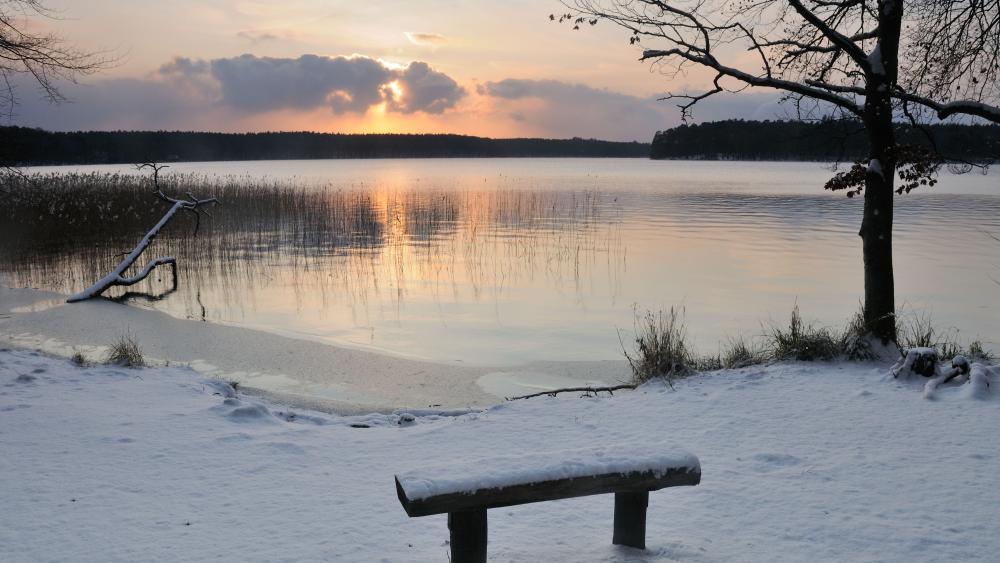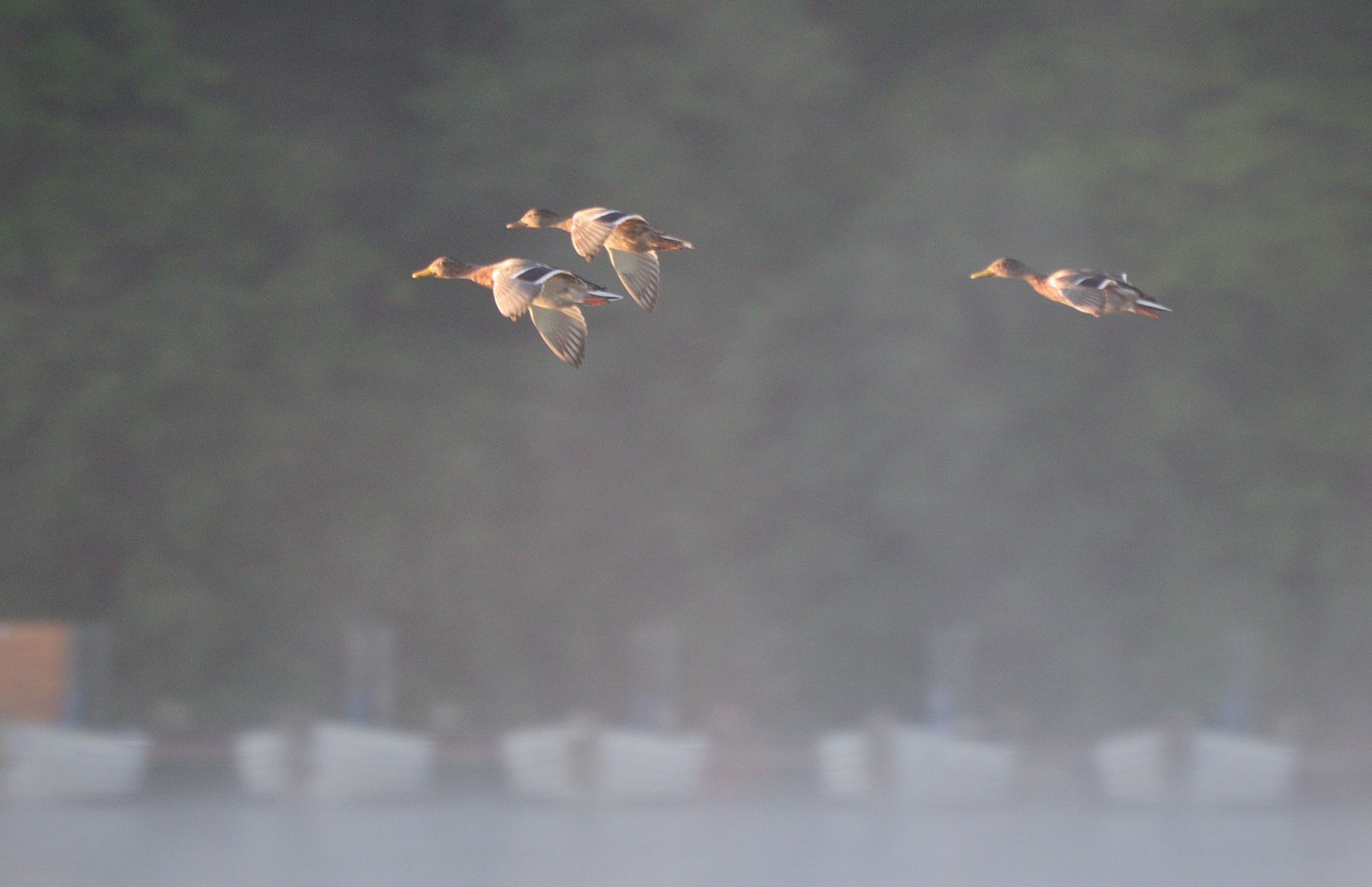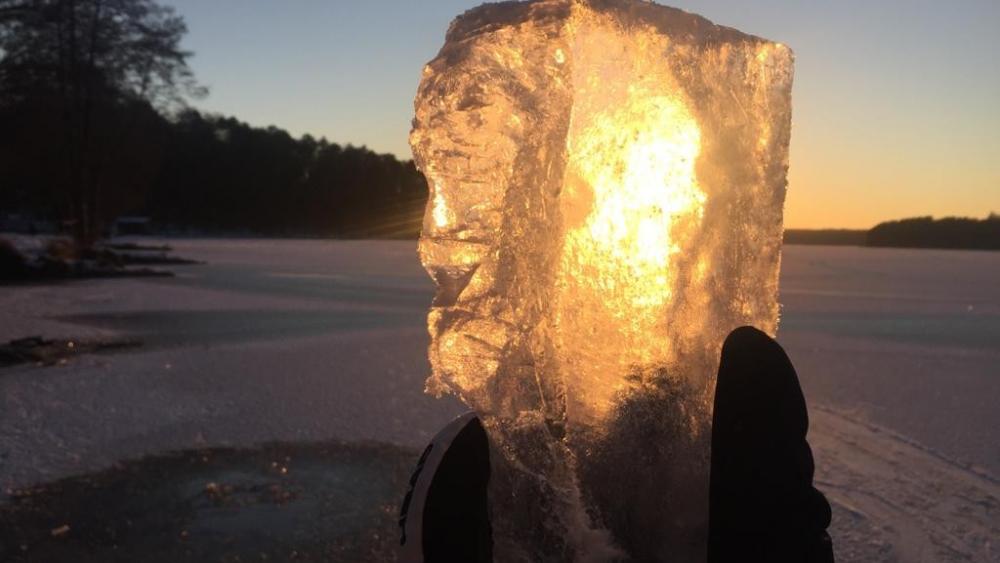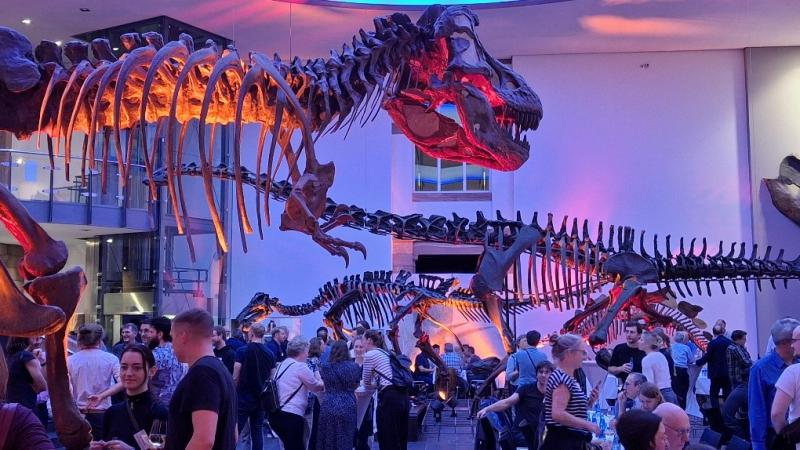
Lake Stechlin in winter. | Photo: Michael Feierabend
When the air gets colder, the water temperature also drops. Due to the special density of water, the layers of water mix until the entire water column has reached a temperature of 4°C. If it gets any colder, the upper layer of deep lakes may freeze while the water below stays at four degrees Celsius. Shallow, well-mixed lakes may cool down further; very shallow lakes may even freeze to the sediment. Native animals and plants developed certain adaptations which help them to survive. Many animals also use the bottom of the water, the sediment, as their winter home. However, there are also cold-adapted organisms, such as some fish species, which only come alive or feed actively in winter, such as pike.

Photo: Michael Feierabend
Frogs in water do not have to surface but breathe through their skin
Amphibians such as frogs, toads and newts hibernate. Frogs and toads – depending on species – can hibernate on land or in water, it just has to be damp or wet. Water frogs, edible frogs and grass frogs often spend their hibernation in water, but not in the water itself, but in the mud at the bottom. Some species, like some fish, can store "antifreeze" in their cells and freeze without dying. As adult amphibians usually have no gills, they actually have to come to the water surface to breathe. During the resting phase in winter, however, they can breathe through their skin. Aquatic plants and phytoplankton normally produce sufficient oxygen for the animals. However, when they become active, they have to surface to catch their breath. If the water is frozen over, however, this can have fatal consequences for the animals. The same applies to low-oxygen situations, especially in excessively nutrient-rich waters and periods of time.
Pond newts and grass frogs flirt early
Pond newts and other native newts often hibernate on land, often in piles of leaves. They migrate to their winter habitats in late autumn, but usually no further than a hundred metres. After or at the same time as the grass frogs, they are one of the first native amphibian species to begin their spawning migration back to the water in February. First the males, then the females make the short journey to the pond. When the water temperature rises to over 5 °C, the courtship begins, a highly interesting behavioural event that resembles a "dance under water".

Photo: Solvin Zankl
Mussels stop growing in winter
Freshwater mussels also hibernate. They lie at the bottom of the water and switch off their metabolism. As a result, they grow much less. Similar to trees, they form annual rings on their shells, which can be used to determine their age.
Fish are usually active and some are more sociable than in summer
Fish remain active in winter. But they tend to be calmer – or so it was thought. A team led by IGB researcher Robert Arlinghaus used telemetry to study the behaviour of carp over the seasons in an entire lake. They found that the animals' behaviour varied throughout the year.
Surprisingly, the carp swam on average about twice as fast in winter as in summer, tended to group together in shoals and spent more time together during the day. In general, however, fish tend to move less in winter because their metabolism is controlled by the temperature. On the other hand, cold-adapted fish species, such as trout, are particularly active in winter. Some, such as burbot, even spawn during this time, or gorge themselves to develop their reproductive organs over the winter, such as pike. Almost all fish are adapted to cold temperatures and therefore have no problems with prolonged cold periods. On the contrary, climate change that reduces winter water temperatures can cause problems with egg maturation in perch and reduced reproduction the following spring.
.jpg)
Photo: Dr. Julian Taffner / Terra Aliens
From a seasonal perspective, Daphnia only have sex before winter
Water fleas, or Daphnia, have nothing in common with animal or human fleas. They are among the smallest representatives of crustaceans, live in freshwater and have a fascinating survival strategy: when things get stressful and living conditions are poor, they lay permanent eggs that can be awakened even after 100 years.
With these permanent eggs, they also withstand the cold season. Normally, the female Daphnia produces unfertilised eggs from which only females develop. However, in autumn or under unfavourable living conditions, males also develop from these eggs and mate with the females. This results in robust permanent eggs with a firm shell for overwintering.The next spring, the fertilised eggs develop into females again and the reproductive cycle begins anew.
Algae can also "bloom" in winter
Reports of mass developments of algae are more common in summer. The amount of algae is usually low in winter due to low light and temperature. However, some algae can attain rather high biomass, even under (clear) ice. This can be particularly the case in small water bodies, such as garden ponds, when leaves or dead plants pollute the water with nutrients. These species have certain characteristics: they have developed a broad temperature tolerance and special survival strategies for cold temperatures - such as cold shock and antifreeze proteins or a cold-resistant cell wall made of unsaturated fatty acids.
Where are aquatic plants in winter?
Most of our native aquatic plants die back in late autumn and survive the cold season as seeds, in permanent stages or as winter buds (turions) on the bottom of the water. The seeds and turions need a cold period before they can germinate again in spring.
Oxygen production by submerged plants is therefore largely reduced in winter, and periods of oxygen-free conditions under ice are more common in lakes with high summer plant biomass than in lakes dominated by algae. However, some species are winter-green and can benefit from the reduced competition for resources in winter to grow. For example, common water moss requires free carbon dioxide, which is also heavily used by algae for photosynthesis in spring and summer, so it grows particularly well in winter. Some species of Charophyceae are also winter green. Dense meadows that cover the sediment can also contribute to oxygen production in winter.

Photo: Michael Feierabend
Waterfowl: heat exchangers in their legs, please don't feed them in winter
Many waterfowl such as swans remain in our climes throughout the winter. Swans are indeed migratory birds, but most European swans feel little urge to leave in winter. Except in northern countries such as Iceland, the animals set off when it is cold. Mallards do not always migrate towards the warmth either, whereas herons and storks do. To prevent freezing on the frozen lake even at low temperatures, the blood circulation in the legs of waterfowl is designed like a heat exchanger. The fine blood vessels are close together so that the warm blood from the body warms the cold blood from the feet. However, should a swan freeze at the tips of its wings - simply call the fire brigade. They will free the bird professionally. It is also important not to feed the waterfowl in winter. They usually find enough to eat in their environment, even in winter. Feeding poses health risks for the animals, impairs the water quality and is also an offence in some areas or cities such as Berlin.
So that no animals die or algae blooms develop in the pond in winter
If you have a pond or pool in your garden, you will find plenty of advice in gardening books or on relevant websites on how to winterise your small water body. So here are just the most important tips: For fish, the pond must be at least 80 to 100 centimetres deep so that the animals cannot freeze to death, and the water surface must not be completely frozen over. Remove and avoid sludge, as this consumes much-needed oxygen in winter. Also remove leaves and cut back aquatic plants. But not all greenery should be removed, as wintergreen plant species are also important oxygen suppliers for fish in the cold season and reeds are useful for gas exchange and as a nursery for insect larvae when the ice cover is closed. You can read here why small bodies of water are so important.

Photo: Stella Berger
By the way, speaking of ice: Here's a safety tip!
Please do not walk on the ice cover of natural water bodies in winter (with the exception of puddles). Currents, inlets, cracks and different qualities of ice (see article: Watch out for white ice! ) can mean that the ice is not safe to walk on despite being sufficiently thick. It is therefore better to use an ice rink or stay on the shore for a snowball fight.
What is the difference between torpor, hibernation and winter rest?
Torpor is a survival strategy of cold-blooded animals such as amphibians, reptiles and insects. Their body temperature adapts to the outside temperature. Within certain limits, of course. If the temperature drops below 10 °C, the animals enter a state of torpor. The animals remain in torpor throughout the cold season. Only the warmth of the sun reactivates the body functions and the animals awaken from this state.
Smaller mammals such as hedgehogs and dormice hibernate. During hibernation, bodily functions are extremely slowed down, body temperature and metabolic activity drop and the heart beats more slowly. In contrast to torpor, the animals are able to reactivate their bodily functions themselves after or during hibernation.
In appearance, winter rest is no different from hibernation. Animals that have winter rest, such as the bear or the badger, withdraw into suitable shelters for several months at the beginning of the cold season. In contrast to hibernation, however, bodily functions are not reduced as much. The animals are therefore quickly back on their feet if they are attacked, for example.











